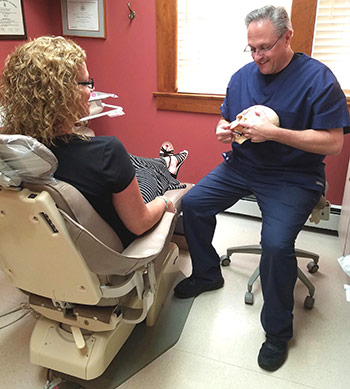About TMJ
It's estimated that tens of millions of men, women, and children suffer from TMJ Disorders. Headaches, facial pain and clicking and popping are the most common complaints from those afflicted with a TMJ dysfunction.
TMJ is an abbreviation for the Temporomandibular Joint, the hinge joint more commonly known as the jaw. This joint, located slightly in front of each ear, is composed of the temporal bone, the mandible, and the disc. This sliding joint, capable of great flexibility, allows for the jaw to be moved by the facial muscles in a wide range of directions.
Unfortunately, your TMJ condition may worsen with time if you do not seek proper treatment. Most patients are not aware that there are specially trained dentists to treat the problem.
The function of the TMJ allows us to talk, chew, and swallow as needed. Problems occur when the ligaments between the two bones of the TMJ are damaged, causing a dislocation of the disc in between. This dislocation can cause clicking, uneven movement of the lower jaw, and/or pain of the TMJ. The right and left TMJ's work dependently on each other. Therefore, if only one joint is injured, overtime, that will strain or injure the other joint.
Symptoms of TMJ Disorders

- Headaches located at the temples, top of the head, or the back of the head
- Migraine type headaches
- Facial muscle pain and tightness
- Ear pain, clogging, and ringing
- Clicking or popping noises from the joints while chewing and opening
- Jaw Pain (which can be radiating from the neck)
- Neck or shoulder pain
- Poor sleep quality
- Locking - inability to open or close the mouth wide as in the past
- Poor posture
- Sensitive teeth and loose teeth
Physical Changes of TMJ Disorders
- Swelling of the cheek muscles
- Slouching or tilting of the head
- Wearing out of teeth
- Over closure of the mouth and lips
- Fullness of the neck
- Crooked Chin - Facial Asymmetry
Causes of TMJ Problems
TMJ problems most often develop from some type of injury and are not hereditary. These TMJ related problems may occur at a very young age from a fall, motor vehicle accident, or direct strike to the chin from sports or other physical activity. Milder type traumas to the TMJ include overextension of the mandible, poor head posture, and chewing habits. Bad sleeping habits, poor posture and incorrect lifting and carrying can also cause a misalignment of the atlas vertebrate (the top cervical bone in the neck) and contribute to symptoms of a TMJ disorder.
Treatment Options for TMJ Dysfunction
Once an appropriate and specific TMJ diagnosis has been established, specific treatment will be offered.
The most common non-surgical therapies include:
- Appropriate occlusal splints to help relieve TMJ muscle tension and create joint support
- Manual muscle therapy to help in proper movement and aid in muscle coordination while relieving TMJ pain and spasm
- Specific nerve block injections, muscle trigger point injections or Botox® injections to address specific local areas of pain source
- Atlas orthogonal therapy to address the atlas bone misalignment which can contribute to headache, neck or back pain, and poor posture
- TMJ pain management with laser and radio frequency energy to ensure the healing of damaged TMJ tissue
- Occlusal equilibration to help balance the bite so the teeth can then support the jaw joint
- Medications to address pain
- Restorative dentistry
- If the injury is deemed severe enough, corrective surgical measures may be necessary. This would be to prevent further changes in muscular or bone structures. In young children, TMJ injuries can lead to improper growth causing facial deformities and alterations in the bite, while in adults the changes are accompanied by regression of the condyle (bone of the mandible connecting within the TMJ) with retrusion of the lower jaw. TMJ disorders can also lead to osteoarthritis
